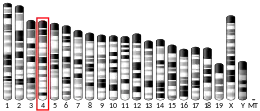Oxysterol binding protein-like 9 is a protein that in humans is encoded by the OSBPL9 gene.[5]
This gene encodes a member of the oxysterol-binding protein (OSBP) family, a group of intracellular lipid receptors. Most members contain an N-terminal pleckstrin homology domain and a highly conserved C-terminal OSBP-like sterol-binding domain, although some members contain only the sterol-binding domain. This family member functions as a cholesterol transfer protein that regulates Golgi structure and function. Multiple transcript variants, most of which encode distinct isoforms, have been identified. Related pseudogenes have been identified on chromosomes 3, 11 and 12.[5]
References
- 1 2 3 GRCh38: Ensembl release 89: ENSG00000117859 - Ensembl, May 2017
- 1 2 3 GRCm38: Ensembl release 89: ENSMUSG00000028559 - Ensembl, May 2017
- ↑ "Human PubMed Reference:". National Center for Biotechnology Information, U.S. National Library of Medicine.
- ↑ "Mouse PubMed Reference:". National Center for Biotechnology Information, U.S. National Library of Medicine.
- 1 2 "Entrez Gene: oxysterol binding protein-like 9". Retrieved 2011-08-30.
Further reading
- Ngo M, Ridgway ND (Mar 2009). "Oxysterol binding protein-related Protein 9 (ORP9) is a cholesterol transfer protein that regulates Golgi structure and function". Molecular Biology of the Cell. 20 (5): 1388–99. doi:10.1091/mbc.E08-09-0905. PMC 2649274. PMID 19129476.
- Gauci S, Helbig AO, Slijper M, Krijgsveld J, Heck AJ, Mohammed S (Jun 2009). "Lys-N and trypsin cover complementary parts of the phosphoproteome in a refined SCX-based approach". Analytical Chemistry. 81 (11): 4493–501. doi:10.1021/ac9004309. PMID 19413330.
- Perttilä J, Merikanto K, Naukkarinen J, Surakka I, Martin NW, Tanhuanpää K, Grimard V, Taskinen MR, Thiele C, Salomaa V, Jula A, Perola M, Virtanen I, Peltonen L, Olkkonen VM (Aug 2009). "OSBPL10, a novel candidate gene for high triglyceride trait in dyslipidemic Finnish subjects, regulates cellular lipid metabolism". Journal of Molecular Medicine. 87 (8): 825–35. doi:10.1007/s00109-009-0490-z. PMC 2707950. PMID 19554302.
- Chen T, Huang Z, Wang L, Wang Y, Wu F, Meng S, Wang C (Jul 2009). "MicroRNA-125a-5p partly regulates the inflammatory response, lipid uptake, and ORP9 expression in oxLDL-stimulated monocyte/macrophages". Cardiovascular Research. 83 (1): 131–9. doi:10.1093/cvr/cvp121. PMID 19377067.
- Wyles JP, Ridgway ND (Jul 2004). "VAMP-associated protein-A regulates partitioning of oxysterol-binding protein-related protein-9 between the endoplasmic reticulum and Golgi apparatus". Experimental Cell Research. 297 (2): 533–47. doi:10.1016/j.yexcr.2004.03.052. PMID 15212954.
- Kimura K, Wakamatsu A, Suzuki Y, Ota T, Nishikawa T, Yamashita R, Yamamoto J, Sekine M, Tsuritani K, Wakaguri H, Ishii S, Sugiyama T, Saito K, Isono Y, Irie R, Kushida N, Yoneyama T, Otsuka R, Kanda K, Yokoi T, Kondo H, Wagatsuma M, Murakawa K, Ishida S, Ishibashi T, Takahashi-Fujii A, Tanase T, Nagai K, Kikuchi H, Nakai K, Isogai T, Sugano S (Jan 2006). "Diversification of transcriptional modulation: large-scale identification and characterization of putative alternative promoters of human genes". Genome Research. 16 (1): 55–65. doi:10.1101/gr.4039406. PMC 1356129. PMID 16344560.
- Sowa ME, Bennett EJ, Gygi SP, Harper JW (Jul 2009). "Defining the human deubiquitinating enzyme interaction landscape". Cell. 138 (2): 389–403. doi:10.1016/j.cell.2009.04.042. PMC 2716422. PMID 19615732.
- Talmud PJ, Drenos F, Shah S, Shah T, Palmen J, Verzilli C, Gaunt TR, Pallas J, Lovering R, Li K, Casas JP, Sofat R, Kumari M, Rodriguez S, Johnson T, Newhouse SJ, Dominiczak A, Samani NJ, Caulfield M, Sever P, Stanton A, Shields DC, Padmanabhan S, Melander O, Hastie C, Delles C, Ebrahim S, Marmot MG, Smith GD, Lawlor DA, Munroe PB, Day IN, Kivimaki M, Whittaker J, Humphries SE, Hingorani AD (Nov 2009). "Gene-centric association signals for lipids and apolipoproteins identified via the HumanCVD BeadChip". American Journal of Human Genetics. 85 (5): 628–42. doi:10.1016/j.ajhg.2009.10.014. PMC 2775832. PMID 19913121.
- Lessmann E, Ngo M, Leitges M, Minguet S, Ridgway ND, Huber M (Feb 2007). "Oxysterol-binding protein-related protein (ORP) 9 is a PDK-2 substrate and regulates Akt phosphorylation". Cellular Signalling. 19 (2): 384–92. doi:10.1016/j.cellsig.2006.07.009. PMID 16962287.
- Jaworski CJ, Moreira E, Li A, Lee R, Rodriguez IR (Dec 2001). "A family of 12 human genes containing oxysterol-binding domains". Genomics. 78 (3): 185–96. doi:10.1006/geno.2001.6663. PMID 11735225.
- Lehto M, Laitinen S, Chinetti G, Johansson M, Ehnholm C, Staels B, Ikonen E, Olkkonen VM (Aug 2001). "The OSBP-related protein family in humans". Journal of Lipid Research. 42 (8): 1203–13. doi:10.1016/S0022-2275(20)31570-4. PMID 11483621.
- Zhou Y, Li S, Mäyränpää MI, Zhong W, Bäck N, Yan D, Olkkonen VM (Nov 2010). "OSBP-related protein 11 (ORP11) dimerizes with ORP9 and localizes at the Golgi-late endosome interface". Experimental Cell Research. 316 (19): 3304–16. doi:10.1016/j.yexcr.2010.06.008. PMID 20599956.
- Bailey SD, Xie C, Do R, Montpetit A, Diaz R, Mohan V, Keavney B, Yusuf S, Gerstein HC, Engert JC, Anand S (Oct 2010). "Variation at the NFATC2 locus increases the risk of thiazolidinedione-induced edema in the Diabetes REduction Assessment with ramipril and rosiglitazone Medication (DREAM) study". Diabetes Care. 33 (10): 2250–3. doi:10.2337/dc10-0452. PMC 2945168. PMID 20628086.
This article incorporates text from the United States National Library of Medicine, which is in the public domain.



